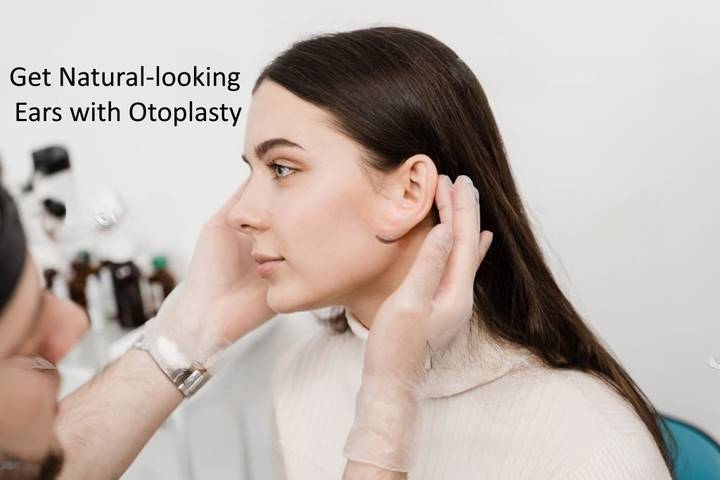Understanding Otoplasty
Otoplasty, also known as ear reshaping surgery, is a cosmetic procedure aimed at improving the appearance of the external ear. A qualified plastic surgeon performs it and can help individuals unhappy with their ears’ shape, size, or position.
1.1 The Purpose of Otoplasty
The primary goal of otoplasty is to correct any aesthetic concerns related to the ears. This procedure can address a variety of issues, including:
Prominent ears: Otoplasty can reduce the prominence of ears that stick out too far from the sides of the head.
Small ears: Otoplasty can enhance the size of small or underdeveloped ears, creating a more balanced appearance.
Congenital ear deformities: Individuals born with absent or malformed external ears can benefit from otoplasty, which can help recreate a more natural-looking ear. (more about congenital ear deformities)
Cartilage defects: Otoplasty can correct problematic excess cartilage or reshape cartilage that contributes to ear irregularities.
1.2 The Otoplasty Procedure
Otoplasty is typically performed under local or general anesthesia, depending on the patient’s preferences and the surgeon’s recommendation. The specific technique may vary based on the individual’s unique needs and desired outcome.
During the procedure, incisions are made on the back of the ear or within the folds, allowing the surgeon access to the cartilage. The surgeon then carefully sculpts, reshapes, or augments the existing cartilage to achieve the desired aesthetic result. Sutures are used to secure the reshaped cartilage and close the incisions.
1.3 Recovery and Results
Following otoplasty, patients will experience a recovery period during which they should follow their surgeon’s instructions for optimal healing. It is common to experience some swelling, bruising, and discomfort in the days following the procedure. Pain medication and cold compresses can help manage any discomfort.
The final results of otoplasty are typically noticeable once the initial swelling subsides. Patients can expect a more aesthetically pleasing appearance of their ears, better proportionality to their faces, and increased self-confidence. It’s important to note that individual healing times may vary, and it may take several weeks to see the full results.
2. The Purpose of Otoplasty
Otoplasty, also known as ear reshaping surgery, is a cosmetic procedure performed by a certified plastic surgeon to alter the external ear’s shape, position, and proportion. This section will delve into the purpose of otoplasty, discussing why individuals choose to undergo this surgical procedure.
Why Do People Choose Otoplasty?
1. Correcting Protruding or Prominent Ears:
One of the most common reasons individuals seek otoplasty is to address the issue of prominent ears. Protruding ears can be a source of self-consciousness and may lead to teasing or bullying, particularly in children. Otoplasty can effectively reposition the ears closer to the head, creating a more balanced and aesthetically pleasing appearance.
2. Resolving Congenital Deformities:
Otoplasty also offers a solution for individuals born with congenital ear deformities. These defects of the pinna, the visible portion of the outer ear, can range from absent external ears to problematic excess cartilage or an underdeveloped rim of the concha. Through otoplasty, these deformities can be corrected, improving the ears’ aesthetic and functional aspects.
3. Enhancing Symmetry and Proportion:
In some cases, individuals may have ears that are noticeably different in size or shape. Otoplasty can address these asymmetries, bringing balance and harmony to the face. By augmenting the cartilaginous support framework of the pinna, a skilled plastic surgeon can subtly reshape and reconstruct the ears, achieving a more proportionate appearance.
4. Correcting Previously Untreated or Unsuccessful Surgeries:
For individuals who have previously undergone otoplasty or other reconstructive ear surgeries with less than satisfactory outcomes, revision otoplasty can help correct any persisting issues. This allows patients to achieve the desired results they may not have attained in their initial procedure.
3. Candidates for Otoplasty
Otoplasty, also known as ear reshaping surgery, is designed to correct the external ear’s shape, size, or position. While it is often considered a cosmetic procedure, it can also be performed for medical reasons, such as correcting congenital ear deformities or reconstructing ears that have been damaged due to trauma.
1. Who is a candidate for otoplasty?
a. Children with prominent ears: One of the most common reasons for otoplasty is to correct prominent ears. Children with ears that stick out more than normal often experience self-esteem issues and may be subject to teasing or bullying. Otoplasty can help create a more balanced and proportionate appearance, boosting their confidence and overall well-being.
b. Adults unhappy with their ear appearance: Otoplasty is not only for children; it can also be performed on adults who are dissatisfied with the appearance of their ears. Whether the concern is related to the size, shape, or position of the ears, otoplasty offers a solution for individuals seeking to enhance their facial harmony.
2. medical condition
a. Congenital ear deformities: Otoplasty is an effective treatment for congenital ear deformities, such as absent external ears or defects of the pinna. In such cases, otoplasty aims to reconstruct a functional and aesthetically pleasing ear, allowing individuals born with these conditions to lead normal lives.
3. The consultation process
a. Evaluation by a plastic surgeon: If you are considering otoplasty, it is important to schedule a consultation with a certified plastic surgeon specializing in ear surgery. They will evaluate your case and discuss your goals, concerns, and expectations for the procedure.
b. Discussion of potential benefits and risks: During the consultation, your plastic surgeon will explain all the potential benefits of otoplasty, such as improved self-confidence and a more balanced facial appearance. They will also discuss any risks or complications associated with the surgery, ensuring you have a comprehensive understanding before deciding.
c. Review of the recovery period: Your surgeon will provide detailed instructions for the recovery period after otoplasty. This may include recommendations for post-operative care, follow-up appointments, and any restrictions or limitations to activities during the healing process.
d. Cost considerations: It is essential to discuss the potential cost of otoplasty
4. Benefits of Otoplasty
Otoplasty, also known as ear reshaping surgery, is a procedure that offers several benefits to individuals who are unhappy with the appearance or functionality of their ears. Whether correcting a medical condition or enhancing aesthetic appeal, otoplasty can significantly improve and boost self-confidence.
Here are some key benefits to consider:
1. Correcting Congenital Ear Deformities:
Otoplasty can effectively address congenital ear deformities, such as prominent ears or absent external ears (microtia).
Surgeons can reshape the ears, creating a more balanced and proportionate look.
2. Enhancing Aesthetic Appearance:
Otoplasty can help individuals who feel self-conscious about their ears’ size, shape, or position.
By repositioning the ears closer to the sides of the head or augmenting the cartilaginous support framework, otoplasty can create a more symmetrical and aesthetically pleasing appearance.
3. Boosting Self-Confidence:
Many people experience psychological distress due to the appearance of their ears. By undergoing otoplasty, individuals can gain a renewed sense of self-confidence and improved body image.
4. Improving Functional Concerns:
Otoplasty is not just limited to cosmetic improvements. It can also address functional issues related to the ears.
For individuals with problematic excess cartilage or defects of the pinna, otoplasty can help improve hearing and overall ear function.
5. Long-Lasting Results:
Otoplasty offers enduring results, allowing patients to enjoy the benefits for years.
While individual experiences may vary, the outcomes of this surgical procedure are typically long-lasting.
6. Customization and Artistic Vision:
Otoplasty procedures are tailored to the specific needs and goals of each patient.
A certified plastic surgeon with expertise in otoplasty can utilize their artistic vision to create natural-looking and harmonious results.
It’s important to note that the benefits of otoplasty can vary depending on individual circumstances and goals. Consulting with a qualified plastic surgeon is crucial to discuss the potential benefits and associated risks or limitations.
5. The Otoplasty Procedure
Otoplasty, also known as ear reshaping surgery, is a cosmetic procedure that focuses on improving the appearance of the external ear. If you’ve ever felt self-conscious about your ears’ shape, size, or prominence, otoplasty may be a viable solution.
(A) What is otoplasty?
Otoplasty is a surgical procedure performed by a certified plastic surgeon. It involves the reshaping and reshaping the visible portion of the outer ear, also known as the pinna. This procedure can address a range of concerns, including correcting prominent ears, reducing the size of large ears, reconstructing absent or defective external ears, and augmenting the cartilaginous support framework of the pinna. Otoplasty can be performed on both children and adults.
(B) How is otoplasty performed?
1. Consultation: Before the procedure, it is crucial to consult with a skilled plastic surgeon who specializes in otoplasty. During this initial consultation, the surgeon will evaluate your ears, discuss your goals and expectations, and explain the surgical process in detail.
2. Anesthesia: Otoplasty can be performed under either general anesthesia or local anesthesia with sedation, depending on the complexity of the surgery and the patient’s preference.
3. Incision: The surgeon will make incisions in inconspicuous locations around the ear, such as behind the ear or within the natural creases.
4. Reshaping: The surgeon will carefully reshape the cartilage and tissue of the ear, addressing the specific concerns discussed during the consultation. This may involve techniques such as folding and suturing the cartilage, removing excess cartilage, or building up the cartilage with autologous rib cartilage grafts.
5. Closing the incisions: Once the desired shape and position are achieved, the incisions will be closed using sutures. These sutures are typically dissolvable or will be removed after a week or two.
6. Recovery: The patient will be monitored in a recovery area after the surgery. It is common to experience mild discomfort, swelling, and bruising, which can be managed with prescribed medication.
7. Follow-up: Regular follow-up visits will be scheduled to monitor the healing process and remove non-dissolvable sutures. Your surgeon will provide comprehensive aftercare instructions to ensure a smooth recovery.
6. Different Techniques of Otoplasty
Otoplasty, also known as ear reshaping surgery, encompasses several techniques that can help individuals achieve the desired appearance of their ears. A skilled plastic surgeon specializing in otoplasty will determine the most suitable technique based on the patient’s unique needs and goals. Here are some of the different techniques commonly used in otoplasty:
1. Conchal Setback Technique:
The plastic surgeon corrects prominent ears by repositioning the conchal cartilage in this technique. The concha is the deepest hollow within the ear and is often responsible for giving ears a protruding appearance.
This technique can create a more balanced and natural-looking ear profile by reshaping the conchal cartilage and bringing it closer to the head.
2. Cartilage Scoring Technique:
This technique involves scoring or making small incisions in the cartilage to weaken its structure, followed by suturing to reshape the ear.
The surgeon strategically places these incisions in the cartilage to create folds and contours that will reposition the ears closer to the head, achieving a more aesthetically pleasing result.
3. Cartilage Reshaping Technique:
The cartilage reshaping technique involves precisely sculpting the ear’s cartilage to correct specific pinna defects–the external ear’s visible portion.
Using their artistic vision and expertise, the plastic surgeon reshapes the cartilage by removing, repositioning, or augmenting it, depending on the desired outcome.
4. Earlobe Reduction Technique:
This technique is used to address the size or shape of the earlobe. It involves removing excess skin and tissue from the earlobe and carefully suturing it for a neater and proportionate appearance.
5. Rib Cartilage Graft Technique:
In cases where a patient has an absent external ear or severe defects of the pinna, the surgeon may use rib cartilage grafts to reconstruct the ear. This technique involves harvesting a small portion of the patient’s rib cartilage, which is then shaped and implanted to create a new ear framework.
7. Risks and Complications of Otoplasty
When considering any surgical procedure, it’s vital to understand the potential risks and complications involved. Otoplasty, or ear reshaping surgery, is no exception. While it is generally a safe procedure, it’s important to be aware of the possible adverse outcomes to make an informed decision. Here are some of the risks and complications associated with otoplasty:
1. Infection:
Like any surgical procedure, there is a risk of infection following otoplasty. However, this risk is relatively low, especially when proper hygiene and post-operative care instructions are followed diligently.
2. Poor wound healing:
Sometimes, the incision site may have difficulty healing properly. Factors such as smoking, certain medications, or underlying medical conditions can contribute to poor wound healing. Disclosing any relevant medical history to your plastic surgeon beforehand is crucial.
3. Hematoma:
A hematoma refers to the accumulation of blood under the skin. While rare, it can occur after otoplasty. Your surgeon will take measures to minimize the risk, such as using drains or compression dressings.
4. Asymmetry:
Achieving perfect symmetry is challenging in any surgical procedure, including otoplasty. While a skilled and experienced plastic surgeon will strive for symmetry, slight variations can occur. These differences are often minimal and barely noticeable.
5. Scarring:
Otoplasty typically involves discreet incisions to reshape the ear. The resulting scars are often well-concealed behind the ear or in natural creases. However, individual healing patterns can vary; in rare instances, thicker or more visible scars may develop.
6. Changes in sensation:
Some patients may experience temporary or permanent changes in sensation around the ear following otoplasty. This can range from mild numbness to a heightened or decreased sense of touch. The majority of individuals regain normal sensation over time.
7. Unsatisfactory results:
While otoplasty can greatly improve the appearance and proportion of the ears, it’s important to have realistic expectations. Occasionally, patients may feel dissatisfied with the outcome, especially if their expectations were unrealistic or they didn’t fully understand the procedure’s limitations. It’s crucial to have open and honest communication with your plastic surgeon to ensure you have a thorough understanding of what can be achieved.
Remember, these risks and complications are generally rare and can be minimized by choosing a qualified
8. Preparing for Otoplasty
Before undergoing otoplasty, it is essential to prepare yourself properly, both physically and mentally. This section will guide you through the steps to ensure a smooth and successful ear-reshaping surgery.
1. Consultation with a Plastic Surgeon:
Schedule a consultation with a certified plastic surgeon who specializes in otoplasty.
During this initial appointment, the surgeon will evaluate your ears, discuss your goals and expectations, and provide personalized recommendations.
2. Discussion of Potential Benefits and Risks:
The surgeon will explain all the potential benefits of otoplasty, including correcting prominent ears, correcting defects of the pinna (outer ear), and enhancing the overall appearance.
They will also discuss any potential risks or complications associated with the procedure, such as infection, bleeding, asymmetry, or unsatisfactory results.
3. Medical Evaluation:
Before the surgery, the plastic surgeon will conduct a thorough medical evaluation to ensure you are in good health and a suitable candidate for the procedure.
They may request blood tests and review your medical history to identify pre-existing conditions affecting the surgery or recovery.
4. Preoperative Instructions:
The surgeon will provide specific instructions to follow in the days leading up to the surgery.
This may include avoiding certain medications that can increase the risk of bleeding, quitting smoking, and arranging for transportation to and from the surgical facility.
5. Anesthesia Options:
Otoplasty can be performed under general anesthesia or local anesthesia with sedation, depending on the complexity of the procedure and the patient’s preferences.
The surgeon will discuss the anesthesia options and help you make an informed decision based on your comfort level.
6. Recovery and Downtime:
I am planning for downtime after otoplasty, which is important to allow for proper healing.
The surgeon will provide detailed instructions on post-operative care, including wound care, pain management, and limitations on physical activities.
7. Financial Considerations:
Otoplasty is considered a cosmetic procedure and is typically not covered by insurance.
During your consultation, the surgeon’s office will provide you with information about the potential cost of the surgery, including any preoperative tests, anesthesia fees, and follow-up visits.
Remember, proper preparation is key to achieving the best results from your otoplasty surgery. Follow your
9. The Experience: What to Expect
Are you considering otoplasty, also known as ear reshaping surgery? Understanding what to expect throughout the otoplasty experience can help alleviate any concerns or uncertainties. Let’s look at the entire process, from the initial consultation to the recovery period.
1. Consultation with a Certified Plastic Surgeon
Before undergoing otoplasty, scheduling a consultation with a certified plastic surgeon is crucial. During this appointment, the surgeon will assess your specific concerns, examine your ears, and discuss the potential benefits and risks of the procedure. They will evaluate whether you are a suitable candidate for otoplasty and address any questions or apprehensions you may have.
2. Discussion of Desired Results and Surgical Techniques
In the consultation, you will have an opportunity to share your goals and desired results for otoplasty. The surgeon can tailor the procedure to meet your needs by understanding your expectations. They will explain the various surgical techniques available, such as correcting protruding ears, resizing or reshaping them, or reconstructing them due to a congenital disability.
“The surgeon will take into consideration the artistic vision and the structural aspects of your ears to achieve the desired outcome,” says Dr. Clinton D. Humphrey, an experienced plastic surgeon with expertise in otoplasty.
3. Anesthesia Options
During the otoplasty procedure, you will receive anesthesia to ensure your comfort. Doctors most commonly perform otoplasty under local anesthesia with sedation, which numbs the targeted area and keeps you relaxed. They may use general anesthesia in more extensive procedures or when combined with other surgeries.
4. Incision Placement and Surgical Technique
The surgeon will make careful incisions in strategic locations, such as behind the ears, where they can be well-concealed. Through these incisions, they will access and reshape the cartilage to achieve the desired aesthetic outcome. Surgeons can augment or alter the cartilaginous support framework of the pinna to correct specific ear irregularities.
5. Correction of Prominent Ears
For individuals with prominent or protruding ears, the surgeon will focus on folding back the cartilage and adjusting its position closer to the sides of the head. This technique helps create a natural-looking contour, bringing the ears into better proportion with the rest of the facial features.
10. Otoplasty Results and Recovery
Once you’ve undergone otoplasty, it’s natural to be curious about the results you can expect and the recovery process. In this section, we will explore what you need to know about the outcomes of ear reshaping surgery and the steps involved in your recovery journey.
1. Otoplasty Results:
Improved Ear Proportions: Otoplasty aims to correct any irregularities or asymmetry in the ears, enhancing overall balance and proportion to the face.
Corrected Ear Position: If your ears protrude prominently, otoplasty can bring them closer to the sides of your head, creating a more pleasing and natural appearance.
Enhanced Ear Contours: It can refine the contours of the outer ear, addressing concerns such as a folded rim of the concha or a prominent helix.
Restored Confidence: Many patients experience a boost in self-confidence and self-esteem following successful otoplasty. The surgery can help you feel more comfortable and at ease with your ear aesthetics.
2. The Recovery Process:
- Initial Bandages: After your otoplasty, your surgeon will apply bandages or dressings to protect the surgical area.
- Pain Management: You may experience discomfort, swelling, and bruising in the first few days. Your surgeon may prescribe pain medication or recommend over-the-counter pain relievers to manage discomfort.
- Follow-up Appointments: Attending the scheduled follow-up appointments with your plastic surgeon is crucial. These visits allow your surgeon to monitor your progress, remove stitches, and assess the healing process.
- Head Positioning: You may need to keep your head elevated and avoid sleeping on your side or directly on your ears to prevent any pressure on the surgical area during the initial recovery period.
Avoid strenuous activities for several weeks after surgery to ensure proper healing. However, your surgeon will provide specific guidelines regarding when to resume normal activities, such as exercising or wearing headphones.
Long-Term Results: It’s important to note that the full results of otoplasty may not be immediately visible due to swelling or residual bruising. Over time, as your ears heal and the swelling subsides, you will be able to appreciate the outcome of the procedure.
Key Takeaway: Otoplasty can lead to improved ear proportions, corrected ear position, enhanced
Conclusion
In conclusion, otoplasty is a safe and effective procedure to help you achieve your desired ears. As discussed, otoplasty can address various cosmetic concerns, such as protruding, asymmetrical, or misshapen ears. By reshaping the ear cartilage, otoplasty can bring balance and harmony to your facial features. Considering otoplasty can be a life-changing decision if you have been struggling with self-confidence due to the appearance of your ears. Consulting with a board-certified plastic surgeon will help determine if otoplasty is right for you. They will assess your goals, thoroughly explain the procedure, and develop a customized surgical plan to meet your needs.
FAQ
What are the possible results of otoplasty?
The results can vary depending on the individual’s desired outcome. However, after the surgery, many people find their ears look more proportionate and attractive.
What are the possible complications?
Otoplasty surgery has a few potential complications, but they are relatively rare. These complications can include infection, bleeding, and a change in hearing.





